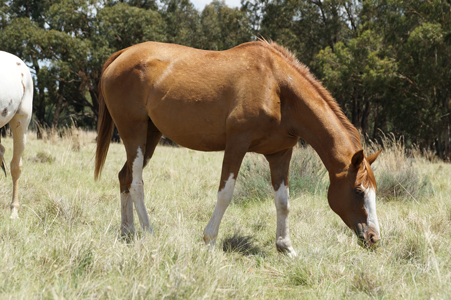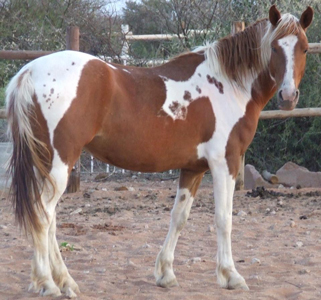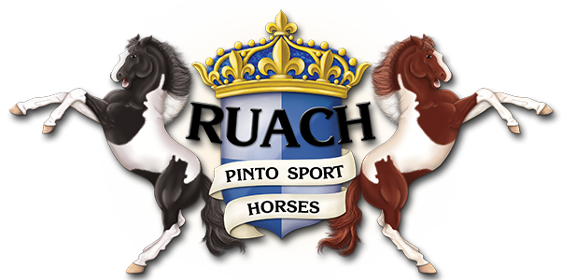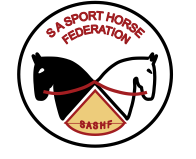What is a pinto or paint horse?
If you have ever seen one in person, then you are probably already aware of how lovely and exquisite these horses are.
Paint or Pinto?
The terms “paint” and “pinto” are sometimes both used to describe spotted horses, but in modern use there is a clear difference between the two terms. A Pinto differs from a Paint solely due to bloodlines. A pinto may be of any breed or combination of breeds, though some Pinto registries may have additional restrictions. For a horse to be registered as an Paint Horse however, it must have registered American Quarter Horse, American Paint Horse, or Thoroughbred parents. Therefore, all Paint horses could be registered as pintos, but not all pintos qualify to be registered as Paints.
A pinto horse has a coat color that consists of large patches of white and any other color. The distinction between “pinto” and “solid” can be tenuous, as so-called “solid” horses frequently have areas of white hair. Various cultures throughout history appear to have selectively bred for pinto patterns.
The pinto horse is marked by some percentage of white hair over un-pigmented skin. The rest of the horse is covered in another color. This other color could be brown, tan or black as well as a combination of any of these. To fully understand the pinto horse, you have to understand the markings and what they represent.

Patterns
- Tobiano: The most common type of pinto, tobiano is a spotting pattern characterized by rounded markings with white legs and white across the back between the withers and the dock of the tail, usually arranged in a roughly vertical pattern and more white than dark, though the ideal is a 50-50 distribution, with the head usually dark and with markings like that of a normal horse. i.e. star, snip, strip, or blaze. Tobiano is a simple dominant trait caused by a single gene. All tobiano horses have at least one tobiano parent. A DNA test exists for tobiano. Tobiano is not associated with any health concerns.
- Overo: This essentially means “pinto, but not tobiano.” It is used to describe frame,splashed white or sabino patterns. These patterns are characterized by irregular markings with a horizontal orientation. The white rarely crosses the back, and the lower legs are normally dark. While most currently-identified overo patterns appear to be dominant traits, overo foals (called “cropouts”) are occasionally produced from two apparently solid-colored parents.
- Frame Overo: Frame is a popular and easily recognized type of non-tobiano pinto. This spotting pattern, in the absence of genes for other patterns, is characterized by horizontally-oriented white patches with jagged, crisp edges. White patches typically include the head, face and lateral aspects of the neck and body, and the eyes are often blue. Frame is an incomplete dominant trait; those without any copies of the “frame gene” (N/N) will not possess this pattern, while those with a single copy (N/O) usually exhibit frame patterning . However, foals born with two copies (O/O) have lethal white syndrome and die shortly after birth. N/O frame horses do not have any known health defects, but may produce lethal white foals if bred to another N/O horse.
- Splashed white: An uncommon type of non-tobiano pinto pattern, splashed white coats have horizontally-oriented white markings with crisp, smooth edges and make the horse appear to have been dipped, head lowered, into white paint. The face has significant white markings, and the eyes are usually blue. Most splashed white pintos have normal hearing, but the trait is linked to congenital deafness.
- Sabino: Sometimes confused with roan or rabicano, sabino horses possess a slight spotting pattern characterized by high white on legs, belly spots, white markings on the face extending past the eyes and/or patches of roaning patterns standing alone or on the edges of white markings.
- Tovero: The tovero spotting pattern is a mix of tobiano and overo coloration, such as blue eyes on a dark head. Horses can carry multiple spotting genes at the same time, producing characteristics of both patterns.
- Dominant white: A family of sabino-like white spotting patterns. All dominant white coats are dominantly inherited. While some forms are associated with pure white coats and are considered “true white,” not pinto, most actually show great variance in the amount of white. The distinction between sabino and dominant white is unclear, as they are visually similar and involve closely related genes. Many breeds of horse carry pinto patterns. Pinto horses have a reputation of being of the hardest working horses. They are very intelligent making them easy to train plus, they’re athletic and very strong. They’re also of the friendliest horses you will ever encounter.




